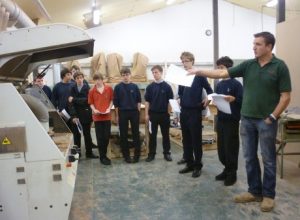Design Technology
 Why We Study It:
Why We Study It:
The intention for all areas of Design and Technology at KS3 is to teach the practical application of the following skills, independence, creativity and analysis. Theory lessons will focus on working properties of materials, sustainability, the design process as well as safety within the workshop environment.
Practical lessons will take up more of the curriculum time allocated so students can work towards improving their skills and abilities to produce accurate and well finished three dimensional outcomes. There is the opportunity for students to work at their own pace, with support and advice given at all stages of the courses. The ability to direct their own creativity allows the students to challenge themselves at all levels. The computerised manufacturing within the department allows students to see first hand the type of equipment used in industry as well as enabling them to push and extend their creativity further. Students have access to fast internet access and high quality computers in our dedicated computer suite.
There is specialist support three lunchtimes a week for all children. Open access every lunchtime to the computers and printer allows all children to be able to complete and achieve their weekly homework.
Our delivery of design and technology at KS4 seeks to prepare students to participate confidently and successfully in an increasingly technological world. It helps students to be aware of, and learn from, wider influences on design and technology, including historical, social/cultural, environmental and economic factors.
We want to enable students to understand and apply iterative design processes through which they explore, create and evaluate a range of outcomes; to use creativity and imagination to design and make prototypes that solve real and relevant problems, whilst considering their own and others’ needs, wants and values. We aim to provide opportunities to apply knowledge from other disciplines, including mathematics, science, art and design, computing and the humanities.Students will develop a knowledge and understanding of different materials and manufacturing processes in order to design and make prototypes with confidence in response to issues, needs, problems and opportunities. Furthermore students will learn how to take design risks, helping them to become resourceful, innovative and enterprising citizens. They should develop an awareness of practices from the creative, engineering and manufacturing industries.
In conclusion, we strive to develop an understanding of designs’ impact on daily life and the wider world, and how high-quality design and technology is important to the creativity, culture, sustainability, wealth and wellbeing of the nation and the global community.
What We Study:
| YEAR 7 | 7:1 Totem Pole Project
As their first introduction to timbers, the Totem Pole project is a very successful vehicle. The focus is on accuracy of marking out, correct manipulation of hand tools and machinery. The main practical focus is on the use of the try square, beveled edge chisel and mallet as well as building skills and confidence when using the scroll saws, pillar drill and sander. There is a large element of creativity involved, pupils are given the opportunity to use acrylic paints to enhance their woodworking skills and produce a final outcome which is both functional and decorative. 7:2 Key Fob Project Looking in depth at the properties and characteristics of Acrylic students get the opportunity to practice using hand tools to experience how the material and tools work first hand prior to designing and developing their own product. |
| YEAR 8 | 8:1 CAD/CAM Clock Project
Looking in depth at the concept of CAD CAM, advantages and disadvantages. Students get the opportunity to develop their prototyping skills and are introduced to an industry standard graphics software called Techsoft 2D Design. They also have the opportunity to further develop their confidence and aptitude when using scroll saws, belt sanders and pillar drills. Critical analysis and evaluative skills are also developed. 8:2 Toy Car Project Building upon their existing skills and knowledge students take control of this project gaining confidence in the workshop. Learning more about ‘jigs’ and orthographic projection students build two cars which they are able to apply their critical analysis and evaluative skills to produce a 3D outcome with high quality and accuracy. |
| YEAR 9 | 9:1 Balancing toy Project
This project is designed to allow pupils to gain an understanding of the fundamentals of basic engineering techniques as well as material properties. The project also contains a substantial element of resistant materials work where the use of jigs, formers and templates are introduced. Alongside this, the use of center lathes and the vertical miller are mainstays of the project. The project allows the use of taps and dies to introduce the techniques of thread cutting. This project is a favourite with both the staff and pupils as it involves a wide range of disciplines and really encourages independent working. 9:2 Night Light Project’ This project is designed to allow pupils to gain an understanding of basic electronic theory by constructing a light activated switch. The electronics element of the project develops our pupil’s logical and analytical skills by understanding the functioning of the circuit and troubleshooting deliberate (theoretical) and actual faults. The project also contains a substantial design element and looks at targeting designs at a chosen demographic. The importance of electronics in society is also studied alongside the environmental impact of electronic consumer products. |
| Year 10
GCSE DT |
In Year 10 the GCSE course allows students to acquire many different practical skills. The year is based on learning new skills such as using hand held power tools. These are popular tools able to be used at home. The course also embellishes the students knowledge and skills of the machinery and equipment used throughout KS3. These varying skills are taught through small practical projects. Several projects incorporate graphical skills in addition to computer based graphics. The laser cutter and 3D router along with the 3d Printer are all experienced throughout the year.
The Students begin the NEA aspect of the qualification in June of year 10. This part of the course is worth 50 % of the final grade and as such most of the remainder of year 10 is dedicated to the NEA. The exam boards publish a range of starting contexts from which the students must decide upon a problem they would like to research and ultimately design a product to solve their chosen problem. |
| Year 11
GCSE DT |
In Year 11 students work continuously on their NEA’s and have to put into practice all that they have learnt over the past 4 years. The students generate their own design brief and specification from which they design and make a fully functioning prototype. This year is a real test to see if the students are capable of working independently and creatively. The final written exam is taken in the summer term of Year 11. |
| Construction | The students gain experience working in building and maintaining the built environment. Knowledge and understanding are developed through a number of theory based and practical tasks relating to roles in the construction industry. A strong core of safe working practices and self critical working practices build the students confidence and skill levels over the two year course. |
KS3 – SCHEME OF ASSESSMENT – 7 week rotation
To ensure consistency and equality each design rotation is assessed in a similar way
| Week 1 | Week 2-6 | Week7 | End of rotation | |
| KS3 | Baseline assessment to establish prior learning and current understanding | During each rotation two pieces of work will be formatively assessed against shared success criteria. EBI/WWW feedback comments are used to inform students of the next steps. | A small online quiz is taken as a homework task at the end of the rotation to assess knowledge acquisition and understanding. This grade then informs the end of unit summative assessment for that rotation. | A final holistic grade will be awarded at the end of the rotation which is generated from the three previous assessment points and a student’s overall effort and attitude. |
| 7.1
Totem Pole |
We assess our students prior learning and current understanding of … | During this rotation formative assessment will be used to measure our students’ design ideas and making skills. | We assess our students’ understanding of … and measure the degree of progress made. | In this rotation we also assess our students’ creativity. |
| 7:2
Key Fob |
We assess our students prior learning and current understanding of … | During this rotation formative assessment will be used to measure our students’ design ideas and ability to evaluate. | We assess our students’ understanding of … and measure the degree of progress made. | In this rotation we also assess our students |
| 8:1
CAD/CAM Clock |
We assess our students prior learning and current understanding of CAD/CAM. | During this rotation formative assessment will be used to measure our students’ design ideas and making skills. | We assess our students’ understanding of CAD/CAM and measure the degree of progress made. | In this rotation we also assess our students prototyping, critical analysis and evaluation skills. |
| 8:2
Toy Car |
We assess our students prior learning and current understanding of timbers and 3D outcomes | During this rotation formative assessment will be used to measure our students’ Isometric Drawing skills and making skills. | We assess our students’ understanding of timbers and 3D outcomes and measure the degree of progress made. | In this rotation we also assess our students
Accuracy and critical analysis skills. |
| 9:1
Balancing Toy |
We assess our students prior learning and current understanding of basic engineering techniques and materials. | During this rotation formative assessment will be used to measure our students’ design ideas and making skills. | We assess our students’ understanding of engineering and measure the degree of progress made. | In this rotation we also assess our students ability to work independently |
| 9:2
Night Light |
We assess our students prior learning and current understanding of basic electronic theory as well as their | During this rotation formative assessment will be used to measure our students’ understanding of the designing a product for an intended audience and electronics theory and construction. | We assess our students’ understanding of electronics and measure the degree of progress made. | In this rotation we also assess our students Logical and analytical skills and their resilience in troubleshooting |
KS4 – SCHEME OF ASSESSMENT
| Autumn Term | Spring Term | Summer Term | |
| Year
10 |
To enhance their practical skills students make a range of simple projects including a wooden puzzle, a laminated wooden implement.
Assessment of these projects is completed via continuous verbal feedback plus a summative report on completion of each project. |
Pupils continue to improve their practical skills, knowledge of materials and processes with further minor projects. A small wooden box is completed.
Assessment of these projects is completed via continuous verbal feedback plus a summative report on completion of each project. |
Component 2 – NEA Internally assessed and externally moderated.
This will be released on 1st June The project will test students’ skills in investigating, designing, making and evaluating a prototype of a product. |
| Year
11 |
We assess students’ understanding of core Design & Technology content as well as Timber related content
Theory lessons and homework take place each week where feedback is given. Component 2 – NEA Internally assessed and externally moderated. |
Mock exam Internal Assessment – Written Paper 1DT0/1F – Timbers.
Component 2 – NEA Internally assessed and externally moderated. |
External Assessment – Written Paper 1DT0/1F – Timbers |

